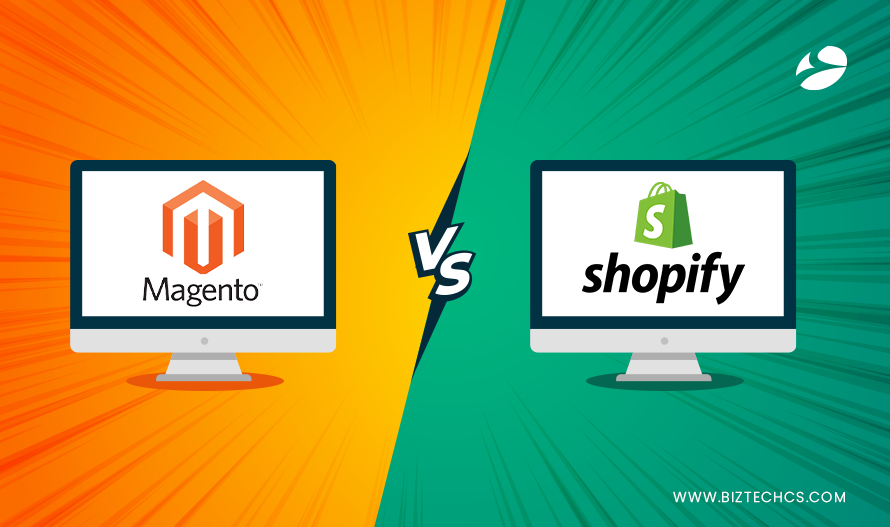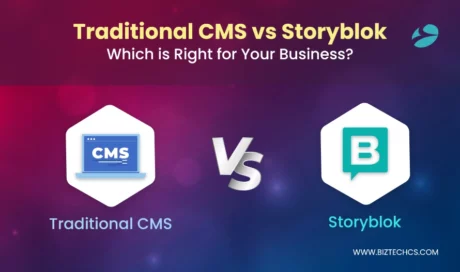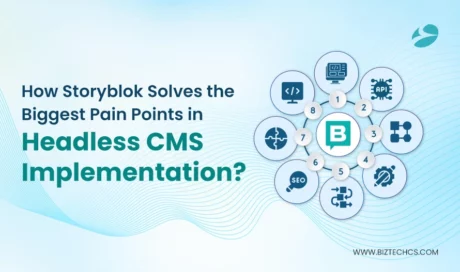Magento vs Shopify: Which is the Best eCommerce Platform in 2023?
16 May, 2023
7 min read
16 May, 2023
7 min read
Table of Content

Torn between the two best eCommerce platforms for your online store? Well, you are not alone! The debate to choose the best between Magento vs. Shopify is going on for a while now.
And it is okay if you haven’t yet figured out the one for your online store. Your eCommerce store is different from millions of others present out there, and of course, it needs a different approach to be successful.
So, I have put together this Shopify vs. Magento guide for all those people out there who are struggling to make a decision. It should help you differentiate the two platforms and decide if Shopify app development is the right choice for you or Magento.
the most suitable one for your eCommerce store.
But, before I differentiate the two platforms, let’s check more about these platforms!
Shopify is an eCommerce platform for developing and managing online stores and POS systems. It is a ready-to-use website builder with a drag-and-drop interface to help with seamless development. The Basic Shopify plan starts from $29 and enables businesses to set up their eCommerce business with minimal investment.
That’s one of the many reasons why Shopify for small businesses works. This fully hosted eCommerce platform comes with several unique features like dropshipping, Shopify POS, powerful analytics tools, SEO tools, order management, etc.
Here, check the various Shopify plans:
| Plans | Basic | Shopify | Advanced | Shopify Plus |
|---|---|---|---|---|
| Pricing | $29/ month | $79/month | $299/ month | Starts $2,000/month |
| Transaction fee (when you use a different payment gateway) | 2% per transaction | 1% per transaction | 0.5% per transaction | 0.25% of monthly revenue |
It is a PHP-based, open-source eCommerce platform that was released about 15 years ago, in March 2008. The eCommerce content management system was later acquired by Adobe Inc. in 2018 for $1.68 billion. The Magento 2.4.6 update is its latest release.
What does Magento do?
If you are wondering how Magento works, let me tell you that it is a ready-to-use CMS. You have plenty of tools, extensions, and themes to choose from and design an eCommerce store that appeases your audience.
Magento comes with several basic to advanced features that make development easier for you. It is highly secure, customizable, and scalable. And has features like order management, SEO, easy checkout, and analytics & reporting.
While the Magento Community edition comes free of cost, Magento Commerce or Adobe Commerce costs start from $1,999/month. Large enterprises that want to leverage the perks of Magento Commerce Cloud will have to pay around $2,688/month.
Read More: How to Change Admin URL in Magento 2?
You already know what Magento and Shopify are and how they work. But, to be able to differentiate and pick the best amongst the two, you need to have a reference point.
A reference of things you would want in your eCommerce store!
Who is your target audience? Are you a startup, SME, or Enterprise? Which features will be ideal for your eCommerce store?
What should be the customization flexibility you expect from the platform? What about security, scalability, and SEO performance? Or, what is the development ease?
Having answers to these common questions will help you understand your needs in a better way! So, here’s a list of the most desired things that eCommerce business owners want/prefer in their stores.
Would you want them too? That’s up to you!
● Hosting and platform ownership
There are several kinds of hosting options available, right from self-hosted platforms to shared hosting. Platforms that support complete hosting are different from the ones where you have to host your site on a server of your choice.
Oftentimes, the platform you choose will decide the kind of hosting you will have to manage for your store. The same goes for platform ownership. You need to choose your pick from open-source, headless, and SaaS-based platforms.
● Cost of ownership
Do you have to pay for the software license? Is there a transaction fee associated? Do you have to take care of hosting separately? You need to take into account all these conditions for pricing.
● App & extension integrations
You don’t just create an eCommerce store and host it on the web. You have to promote it, market it, and optimize it for sales and SEO.
All of these are possible by integrating apps and extensions. Because your eCommerce developer can’t build everything from scratch. So, integration capability is a thing you must consider.
● Designs and themes
Do you know 88% of customers won’t bother returning to a site with poor UX?
That’s how important the front-end design and user experience are for your online store! So, taking a look at the design capabilities and themes available is a must.
● Speed & scalability
Slow load times, frozen pages, sluggish performance, and 404 pages can affect your store’s performance dramatically. Thus, choosing a platform with speed and scalability becomes the most important.
● Security
When customers purchase products from your site, they trust you with crucial information. And not just that, they trust your site and perform monetary transactions. So, security is a crucial aspect to consider.
● SEO
Prepping your store for SEO compatibility is something you can’t compromise on. You need to build an SEO-friendly store to get more visitors.
And the eCommerce platform you choose will definitely help you make it SEO-compatible. So, check for various SEO support features amongst Shopify and Magento to decide for yourself.
● Payment gateway support
Secure payment integrations are a must for your eCommerce business. But, at the same time, you also have to choose an eCommerce platform that supports a wide array of payment gateways. It will help create a smoother buying journey for your primary customer base.
These points should help you compare Shopify Plus vs Magento and decide the best platform for your store!
Now that you know about things your eCommerce store must have, let’s check these Shopify vs Magento coalition points.
| Attributes | Shopify | Magento |
|---|---|---|
| Launched in | 2006 | 2008 |
| Developed on | Ruby | PHP |
| Solution type | Opens-source | Hosted |
| Solution type | Opens-source | Hosted |
| Web hosting included | Yes | No |
| Unlimited eCommerce products | Yes | Yes |
| POS System | Yes | Hosted |
| Unlimited Bandwidth | Yes | No |
| 24 x 7 Support | Yes, via
|
Yes, via
|
Multi-currency support130+200+Pros
| No-code store development | Yes | No |
|---|---|---|
| Mobile app for eStore owners | Yes | No |
| Suitable for | Small-scale businesses with a limited product range | Small to large-scale enterprises |
| Number of apps/extensions | 4200+ | 3600+ |
| Cons |
|
|
The above table should help you with the basic differences between the two eCommerce platforms. However, if you want to dig deeper into the various features and functionalities of Magento and Shopify, this should help.
Ease of Use: Shopify Vs. Magento
Shopify is a one-stop-shop. With its drag-and-drop website builder, ready-to-use Shopify themes, and plugins, you can easily create your store in minutes.
It is one of the many reasons to choose Shopify for your eCommerce store development.
Whereas, Magento has a steep learning curve. It is quite difficult for a beginner to learn the tech jargon and coding needed for development. In most cases, you will need to look for Magento reviews and hire a Magento developer.
Winner: Shopify
The number of themes and templates in Magento is over 300. Whereas, the number of Shopify themes and templates crosses over 1600.
Clearly, Shopify has more variety to offer!
Moreover, there are about 16 Shopify free themes and over 60 premium themes. The average cost of these Shopify themes ranges between $140 to $180.
If you use a readymade Magento theme, it will cost around $100. However, custom themes start from $600 to $25,000.
Winner: Shopify
The Magento eCommerce pricing consists of several variables. The license fee is zero as the community edition is free of cost. However, if you use Magento Commerce or Magento Cloud, you will have to pay certain charges as mentioned below.
| Average Gross Sales Revenue | Magento Commerce Cost | Magento Commerce Cloud Cost |
|---|---|---|
| Less than $1M | $22,000/year | $40,000/year |
| $1M to $5M | $32,000/year | $55,000/year |
| $5M to $10M | $49,000/year | $80,000/year |
| $10M to $25M | $75,000/year | $120,000/year |
| $25M+ | $125,000/year | $190,000/year |
Besides these, you also have to pay for acquiring a Magento theme, extensions, and hosting options.
The Shopify pricing starts from $29 and is illustrated in the table below.
| Basic | Shopify | Advanced | |
|---|---|---|---|
| Pricing | $29/month | $79/month | $299/month |
| Shipping discount | Up to 77% | Up to 88% | Up to 88% |
| Online credit card rates | 2.9% + 30c USD | 2.6% + 30c USD | 2.4% + 30c USD |
| In-person credit/debit card rates | 2.7% + 0c USD | 2.5% + 0c USD | 2.4% + 0c USD |
| Transaction fee for non-Shopify payments | 2% | 1% | 0.5% |
Besides these, you also have to pay for Shopify domain name, themes and designs, apps and integrations, etc. The cost to avail of Shopify development services should also be considered.
Winner: Both Shopify and Magento have different costs associated with the platform. Though Shopify plans start from a minimal cost, they can get big if you have extreme customization in mind. Similarly, the cost with Magento can shoot up depending on the kinds of themes and extensions you use. Or, the level of customization.
Magento is highly scalable. You can customize a store in Magento to be highly flexible for your increasing demands. The online store will be able to handle more traffic and function without a glitch.
Though you can do the same with Shopify, you will have to upgrade to a suitable plan for doing so. Not only will it cost more, but the transaction fee will also be huge. So, it might not be your best option if you are an enterprise with huge daily transactions.
Winner: Magento
Shopify has over 1,200 free and premium apps for shipping, email marketing, social media promotion, and more. The apps are very secure and can be easily integrated into your store.
As for Magento, you can choose from 5,000 extensions. About 1,970 of these extensions are free, the other 10% cost approximately $30, and the rest can go up to $2,000. However, integrating Magento extensions isn’t as easy as installing Shopify apps.
You will need technical expertise for the integration. Besides, you also have to be careful choosing the extensions as some of those may not be updated regularly or have security issues.
Winner: Shopify if you look for ease and more refined apps, Magento if you have experts to handle the integration and customization.
Magento comes with plenty of in-built SEO features and guides to help you get started. It helps you add/edit metadata, add image alt tags, and change URLs as needed. You can further improve your store’s SEO with integration.
In terms of SEO, Shopify majorly depends on its apps. If you want to do more than add image alt tags and edit page titles, you will have to search for suitable SEO apps from the app store.
SEO compatibility is one of the many reasons many businesses migrate from Shopify to Magento.
With the help of the Dropship extension in Magneto 2, you can easily connect with a supplier for dropshipping. You can do it from the Admin panel of the Order Management tab itself. So, you don’t need any 3rd party tools for this.
In Shopify, you can integrate Oberlo to easily find products from a wide range of suppliers and dropship. There are plenty of apps like Spocket, Trendsi Fashion Dropshipping, AO- AliExpress Dropshipping, and AutoDS All-in-One Dropshipping that support your Shopify dropshipping venture.
Winner: Both Shopify and Magento provide seamless options for drop shipping.
Both Magento and Shopify are leading eCommerce platforms available today. They come with comprehensive features, themes, and tools to help with development. While Shopify is a more easy-to-use option, Magento requires more technical expertise.
Besides, Shopify is apt for small to medium-scale businesses that handle a limited number of transactions each day. If you have a bigger target audience to appease, Magento might be the better option.
It gives you tremendous customization capabilities and you can scale up your store without switching to a different plan. Businesses also have the Magento Shopify integration option as they can integrate both their stores and sync products, orders, etc. for seamless management.
In a nutshell, your target audience and requirements will help you decide the best among the two! So in the end, no matter what you choose, we are here to help you with the technical aspects.
Being a Magento Bronze partner and having worked on Shopify plus projects, we have experience with both technologies. So, regardless of your choice, we can help you build a profitable eCommerce store.
You can also check our Magento to Shopify migration checklist if you want to migrate or seek help from our developers.

Storyblok
28953
By Devik Gondaliya
02 Apr, 2025

Storyblok
29932
By Devik Gondaliya
01 Apr, 2025

Storyblok
30599
By Devik Gondaliya
27 Mar, 2025